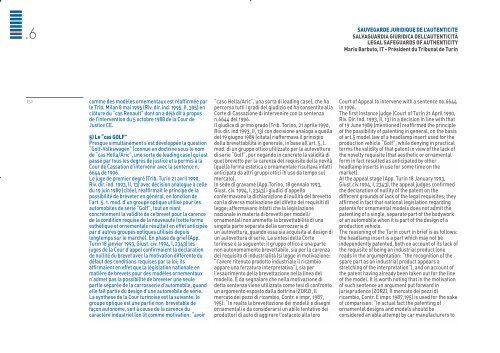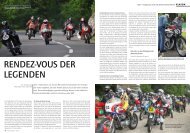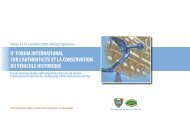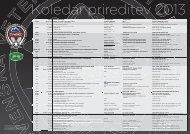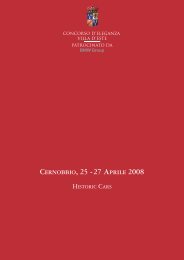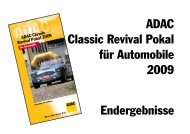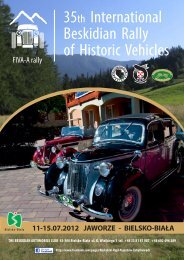FORUM INTERNATIONAL SUR L'AUTHENTICITE DU VEHICULE HISTORIQUE ...
FORUM INTERNATIONAL SUR L'AUTHENTICITE DU VEHICULE HISTORIQUE ...
FORUM INTERNATIONAL SUR L'AUTHENTICITE DU VEHICULE HISTORIQUE ...
You also want an ePaper? Increase the reach of your titles
YUMPU automatically turns print PDFs into web optimized ePapers that Google loves.
.6<br />
152<br />
comme des modèles ornementaux est réaffirmée par<br />
le Trib. Milan 8 mai 1995 (Riv. dir. ind. 1995, II, 395) en<br />
clôture du “cas Renault” dont on a déjà dit à propos<br />
de l’intervention du 5 octobre 1988 de la Cour de<br />
Justice CE.<br />
5) Le “cas GOLF”<br />
Presque simultanément s’est développée la question<br />
“Golf-Volkswagen” (connue en doctrine sous le nom<br />
de “cas Hella/Aric”, une sorte de leading case) qui est<br />
passé par tous les degrés de justice et a permis à la<br />
Cour de Cassation d’intervenir avec la sentence n.<br />
6644 de 1996.<br />
Le juge de premier degré (Trib. Turin 21 avril 1990,<br />
Riv. dir. ind. 1993, II, 13) avec décision analogue à celle<br />
du 19 juin 1989 (citée), réaffirmait le principe de la<br />
possibilité de breveter en général, en fonction de<br />
l’art. 5. 1. mod. d’un groupe optique utilisé pour les<br />
automobiles de série “Golf”, tout en niant<br />
concrètement la validité de ce brevet pour la carence<br />
de la condition requise de la nouveauté (cette forme<br />
esthétique et ornementale résultait en effet anticipée<br />
par d’autres groupes optiques utilisés depuis<br />
longtemps sur le marché). En phase de grief (App.<br />
Turin 18 janvier 1993, Giust. civ. 1994, I, 2343) les<br />
juges de la Cour d’appel confirmaient la déclaration<br />
de nullité du brevet avec la motivation différente du<br />
défaut des conditions requises par la loi; ils<br />
affirmaient en effet que la législation nationale en<br />
matière de brevets pour des modèles ornementaux<br />
n’admet pas la possibilité de breveter une seule<br />
partie séparée de la carrosserie d’automobile, quand<br />
elle fait partie du design d’une automobile de série.<br />
La synthèse de la Cour turinoise est la suivante: le<br />
groupe optique est une partie non brevetable de<br />
façon autonome, soit à cause de la carence du<br />
caractère industriel (on lit comme motivation: “avoir<br />
“caso Hella/Aric”, una sorta di leading case), che ha<br />
percorso tutti i gradi del giudizio ed ha consentito alla<br />
Corte di Cassazione di intervenire con la sentenza<br />
n.6644 del 1996.<br />
Il giudice di primo grado (Trib. Torino, 21 aprile 1990,<br />
Riv. dir. ind 1993, II, 13) con decisione analoga a quella<br />
del 19 giugno 1989 (citata) riaffermava il principio<br />
della brevettabilità in generale, in base all’art. 5, l.<br />
mod. di un gruppo ottico utilizzato per le autovetture<br />
di serie “Golf”, pur negando in concreto la validità di<br />
quel brevetto per la carenza del requisito della novità<br />
(quella forma estetica e ornamentale risultava infatti<br />
anticipata da altri gruppi ottici in uso da tempo sul<br />
mercato).<br />
In sede di gravame (App.Torino, 18 gennaio 1993,<br />
Giust. civ. 1994, I, 2343) i giudici d’appello<br />
confermavano la dichiarazione di nullità del brevetto<br />
con la diversa motivazione del difetto dei requisiti di<br />
legge; affermavano infatti che la legislazione<br />
nazionale in materia di brevetti per modelli<br />
ornamentali non ammette la brevettabilità di una<br />
singola parte separata della carrozzeria di<br />
un’autovettura, quando essa sia acquisita al design di<br />
un’autovettura di serie. La sintesi della Corte<br />
torinese è la seguente: il gruppo ottico è una parte<br />
non autonomamente brevettabile, sia per la carenza<br />
del requisito di industrialità (si legge in motivazione:<br />
“l’avere ritenuto prodotto industriale il ricambio<br />
appare una forzatura interpretativa”), sia per<br />
l’esaurimento della brevettazione nella linea del<br />
modello. È da segnalare che nella motivazione di<br />
detta sentenza viene utilizzata come tesi di confronto<br />
un argomento esposto dalla dottrina (ZORZI, Il<br />
mercato dei pezzi di ricambio, Contr. e impr, 1987,<br />
195): “In realtà la brevettazione dei modelli e disegni<br />
ornamentali è da considerarsi un abile tentativo dei<br />
produttori di auto di aggirare l’ostacolo alla loro<br />
SAUVEGARDE JURIDIQUE DE L’AUTENTICITE<br />
SALVAGUARDIA GIURIDICA DELL’AUTENTICITÀ<br />
LEGAL SAFEGUARDS OF AUTHENTICITY<br />
Mario Barbuto, IT - Président du Tribunal de Turin<br />
Court of Appeal to intervene with a sentence no.6644<br />
in 1996.<br />
The first instance judge (Court of Turin 21 April 1990,<br />
Riv. Dir. Ind. 1993, II, 13) in a decision in line with that<br />
of 19 June 1989 (mentioned) reaffirmed the principle<br />
of the possibility of patenting in general, on the basis<br />
of art.5 model law of a headlamp insert used for the<br />
production vehicle “Golf”, while denying in practical<br />
terms the validity of that patent in view of the lack of<br />
the novelty requisite (that aesthetic or ornamental<br />
form in fact resulted as anticipated by other<br />
headlamp inserts in use for some time on the<br />
market).<br />
At the appeal stage (App. Turin 18 January 1993,<br />
Giust.civ.1994, I, 2343), the appeal judges confirmed<br />
the declaration of nullity of the patent on the<br />
different grounds of lack of the legal requisites; they<br />
affirmed in fact that national legislation regarding<br />
patents for ornamental models does not admit the<br />
patenting of a single, separate part of the bodywork<br />
of an automobile when it is part of the design of a<br />
production vehicle.<br />
The reasoning of the Turin court in brief is as follows:<br />
the headlamp insert is a part which may not be<br />
independently patented, both on account of its lack of<br />
the requisite of being an industrial product (one<br />
reads in the argumentation: “the recognition of the<br />
spare part as an industrial product appears a<br />
stretching of the interpretation”), and on account of<br />
the patent having already been taken out for the line<br />
of the model. It is worth noting that in the motivation<br />
of such sentence an argument put forward in<br />
jurisprudence (ZORZI, Il mercato dei pezzi di<br />
ricambio, Contr. E impr. 1987,195) is used for the sake<br />
of comparison: “In actual fact the patenting of<br />
ornamental designs and models should be<br />
considered an able attempt by car manufacturers to


